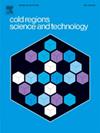冻土-混凝土界面的介观剪切演变特征
IF 3.8
2区 工程技术
Q1 ENGINEERING, CIVIL
引用次数: 0
摘要
受冻混凝土界面的力学性能影响着寒冷地区工程结构的稳定性和耐久性。为了研究这些特性,我们进行了实验室试验和数值模拟,以研究剪应力-位移关系的中观演变和界面的剪切过程。在不同的环境温度(-2 °C、-5 °C 和 -10 °C)和法向应力(100 kPa、200 kPa 和 300 kPa)下,对冻土-混凝土界面进行了直接剪切试验,并建立了直接剪切的粒子流代码(PFC)模型。利用 PFC 模型模拟了剪切过程中界面的中观参数(颗粒位移、旋转、力链、应力、配位数、孔隙度、结构等)。此外,还根据实验数据确定了界面温度、内聚力和摩擦系数之间的关系,并利用先前的实验数据验证了 PFC 模型的准确性。PFC 剪切模型的结果与实验室试验的结果吻合,很好地模拟了剪切带的形成。剪切带外上层土体颗粒位移均匀,方向一致,而剪切带内土体颗粒位错和旋转差异明显。在剪切过程中,力链、应力场、配位数、孔隙度等均相似,并呈现出与剪切运动方向相反的集中分布,反映了颗粒在宏观外力作用下微观响应的一致性。本研究中的温度、内聚力和摩擦系数回归方程可用于模拟冻土-混凝土界面在不同温度和法向应力下的剪切行为。本文章由计算机程序翻译,如有差异,请以英文原文为准。
Mesoscopic shear evolution characteristics of frozen soil-concrete interface
The mechanical properties of frozen-concrete interfaces affect the stability and durability of engineering structures in cold regions. To investigate these properties, laboratory tests and numerical simulations were conducted to study the mesoscopic evolution of the shear stress-displacement relationship and the shearing process at the interface. The direct shear tests were performed at different environmental temperatures (−2 °C, −5 °C, and −10 °C) and normal stresses (100 kPa, 200 kPa, and 300 kPa) on the frozen soil-concrete interface, and Particle Flow Code (PFC) model of direct shear was developed. The mesoscopic parameters (particle displacement, rotation, force chain, stress, coordination number, porosity, fabric, etc.) of the interface during shearing were simulated using the PFC model. Moreover, the relationship among the interface temperature, cohesion, and friction coefficient was determined based on experimental data, and the accuracy of the PFC model was verified using previous experimental data. The results of the PFC shear model aligned well with those of the laboratory test, and the formation of shear bands was simulated well. The displacement of the soil particles on the upper layer outside the shear zone was uniform, and the direction was the same, whereas the particles inside the shear zone showed significant differences in the dislocation and rotation of the soil particles. The force chain, stress field, coordination number, and porosity were similar in the shear process and showed a concentrated distribution in the opposite direction of the shear motion, which reflected the consistency of the microcosmic response of the particles under the action of macroscopic external forces. The regression equations for the temperature, cohesion, and friction coefficient in this study can be used to simulate the shear behavior of frozen soil-concrete interfaces under different temperatures and normal stresses.
求助全文
通过发布文献求助,成功后即可免费获取论文全文。
去求助
来源期刊

Cold Regions Science and Technology
工程技术-地球科学综合
CiteScore
7.40
自引率
12.20%
发文量
209
审稿时长
4.9 months
期刊介绍:
Cold Regions Science and Technology is an international journal dealing with the science and technical problems of cold environments in both the polar regions and more temperate locations. It includes fundamental aspects of cryospheric sciences which have applications for cold regions problems as well as engineering topics which relate to the cryosphere.
Emphasis is given to applied science with broad coverage of the physical and mechanical aspects of ice (including glaciers and sea ice), snow and snow avalanches, ice-water systems, ice-bonded soils and permafrost.
Relevant aspects of Earth science, materials science, offshore and river ice engineering are also of primary interest. These include icing of ships and structures as well as trafficability in cold environments. Technological advances for cold regions in research, development, and engineering practice are relevant to the journal. Theoretical papers must include a detailed discussion of the potential application of the theory to address cold regions problems. The journal serves a wide range of specialists, providing a medium for interdisciplinary communication and a convenient source of reference.
 求助内容:
求助内容: 应助结果提醒方式:
应助结果提醒方式:


